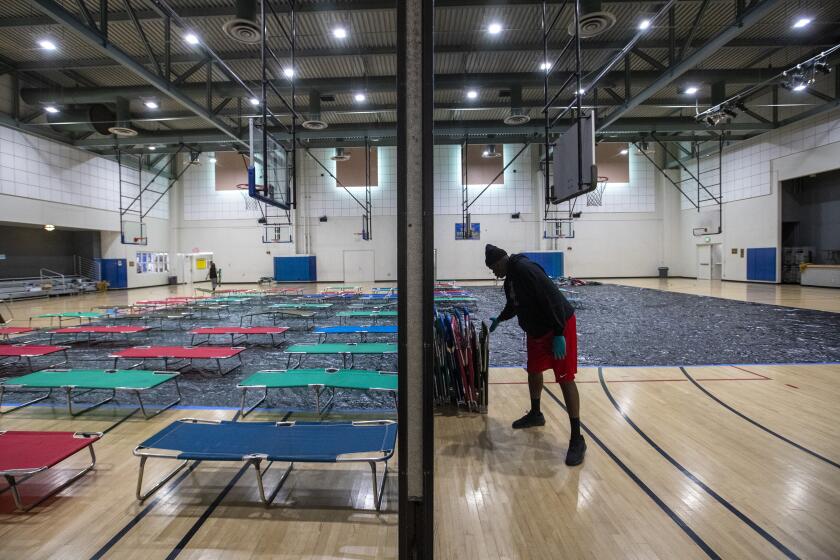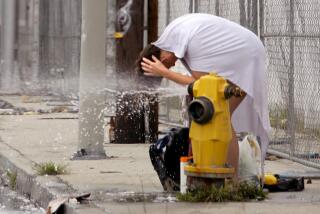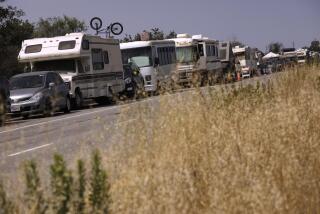Have L.A.’s homeless people dodged a COVID-19 catastrophe?
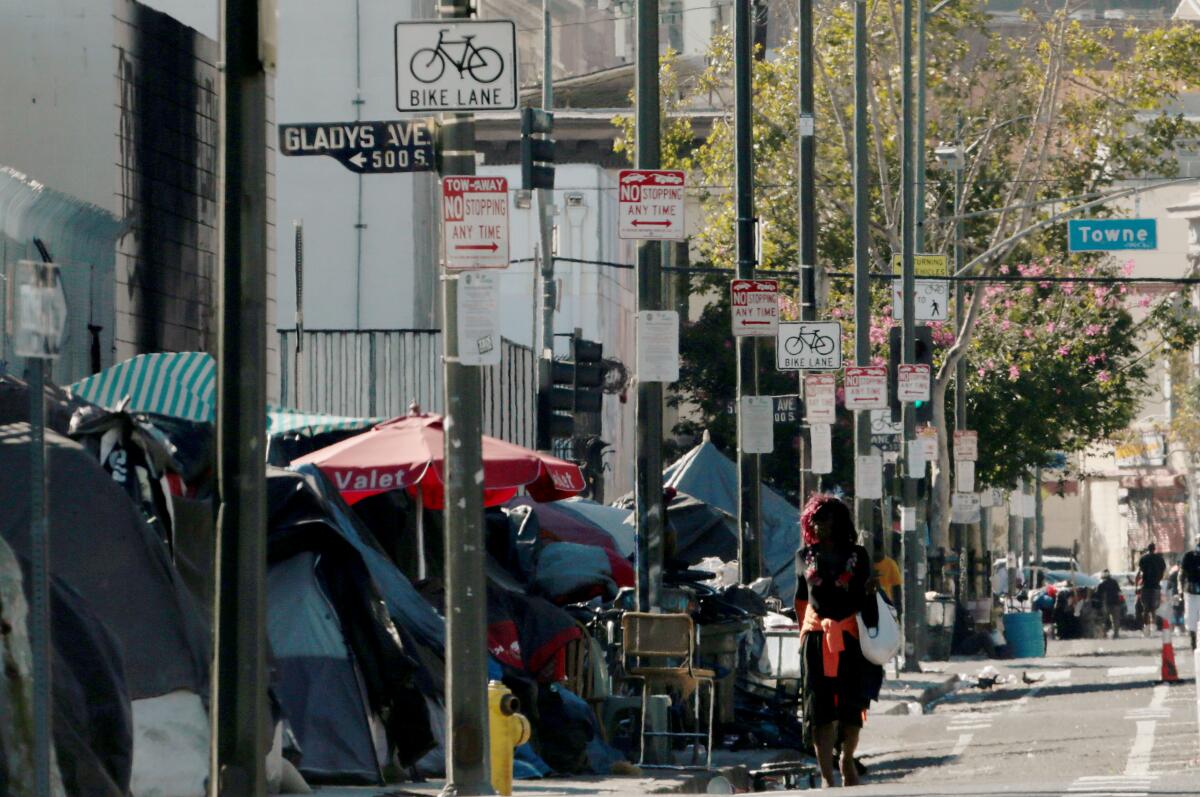
- Share via
When the COVID-19 pandemic erupted, advocates predicted that a “time bomb” was about to go off in the homeless community.
Many homeless people live under conditions worse than those of a refugee camp, with health problems that predispose them to severe illness. Researchers feared they’d succumb in high numbers to the worst ravages of the disease.
But the powder keg has yet to go off. There has been little spread of the novel coronavirus in Los Angeles’ street encampments. Some shelters have had outbreaks, but most of those infected had no symptoms.
Of the more than 1,300 cases among homeless people in L.A. County, fatalities by mid-August stood at 31, a mortality rate comparable to or better than that of the overall population. An influential early paper had estimated the numbers were likely to go as high as 400 deaths and 2,600 hospitalizations.
“It definitely is and has been better than we expected,” said Heidi Marston, executive director of the Los Angeles Homeless Services Authority. Marston and county officials said an aggressive public health response, including a homeless hotel program, is paying off.
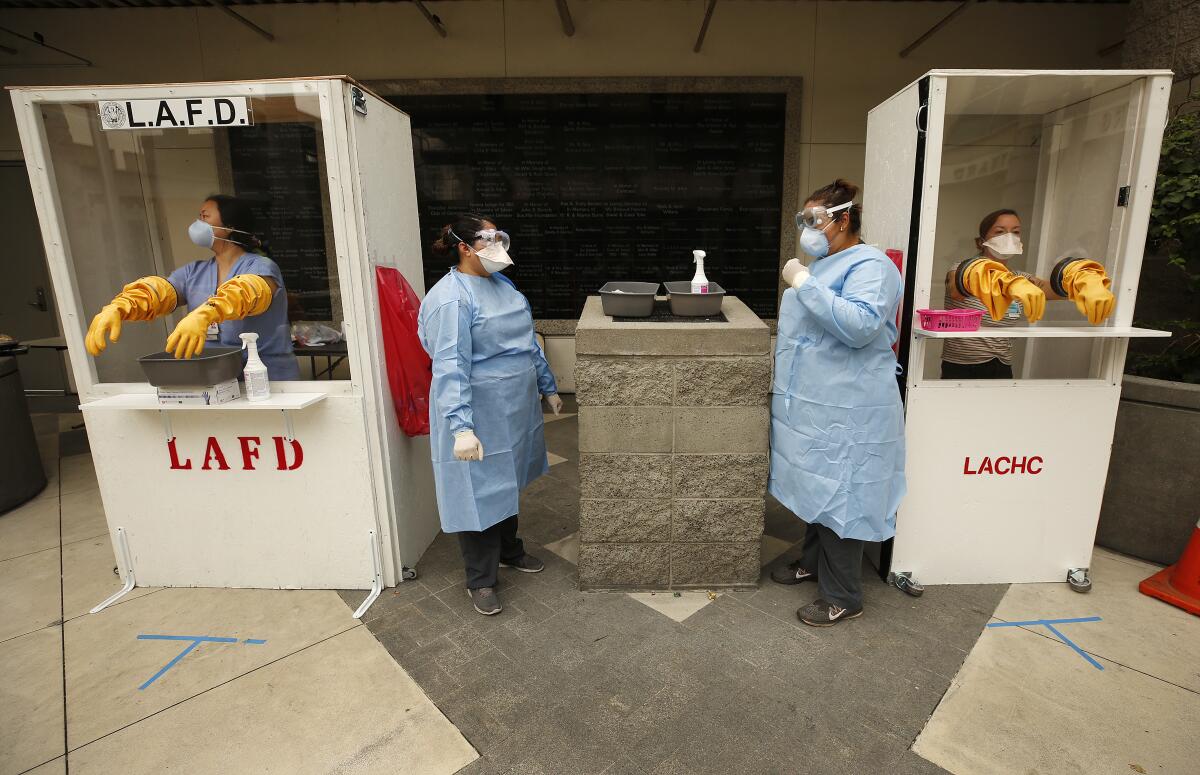
But homeless people in the rest of California and across the nation have had a better-than-expected time of it as well. And one reason might be the environment where nearly three-quarters of L.A.’s homeless people live: outside.
Social distancing is what everyone does with homeless people.
— UCLA associate professor Randall Kuhn
Living outside normally “weathers” homeless people, teeing them up for a host of diseases and early death. But during COVID-19 crisis, outside is safer than indoors because fresh air disperses droplets containing the virus and there’s more room to keep people apart, the Centers for Disease Control and Prevention has said. A small Japanese study released in April found the risks of transmission in a closed space were 19 times greater than in the open.
Of the 83 homeless service settings that Los Angeles County officials tracked for COVID-19 outbreaks, 19% were encampments, with 11% of the cases. The rest were shelters, hotels or recuperative centers.
“It’s possible being outside is protective relative to inside,” said Dennis P. Culhane, University of Pennsylvania professor and homelessness researcher who co-authored the early COVID-19 study.
Even in shelters, COVID-19 has not been the catastrophe that was predicted. Shelters in Boston, San Francisco and Nashville have had outbreaks, and at the Union Rescue Mission on skid row, 107 residents and staff were infected, leading to three deaths.
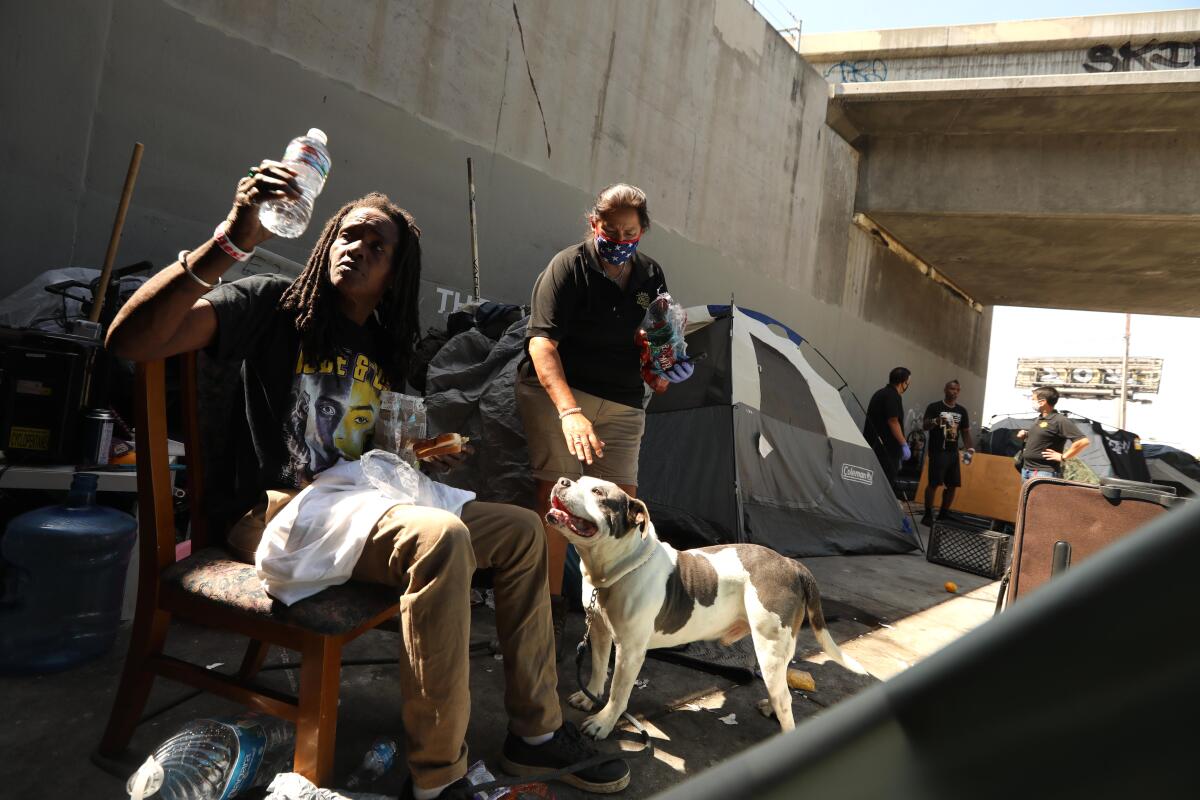
But most of those infected had no symptoms: In Boston, where every shelter resident was tested, the asymptomatic rate was 70% to 90%, said Dr. James O’Connell, assistant professor at Harvard Medical School and president of Boston Health Care for the Homeless Program, who called the finding “bizarre.”
“There is still much to learn to try to understand what truly impacts susceptibility,” said Dr. Anne Rimoin, professor of epidemiology at UCLA.
The apparent resiliency of homeless people in the face of a pandemic has so confounded expectations that researchers are looking at disparate and sometimes far-fetched causes. A small French study found less severe and symptomatic COVID cases among heavy smokers (most homeless people use tobacco). But an Italian study concluded the opposite, O’Connell said.
Researchers linked deficiencies of Vitamin D, which is absorbed from the sun, to more severe cases of COVID-19. But homeless people in Boston were tested and have the same vitamin deficiencies as other people, O’Connell said.
Could the virus have mutated into a milder strain? Or did homeless people build up a special resistance from bouts with previous coronaviruses or other illnesses?
“It has certainly crossed my mind, although I’m not sure there is any data to support that,” said Margot Kushel, professor of medicine at UC San Francisco and head of a university institute to end homelessness. “An easier explanation is the data on homeless infections is poor, and the homeless community is cut off from the rest of society.”
“We weren’t doing no traveling,” skid row resident Donald Stratton, 59, said last month, adding that he doesn’t know anyone who has tested positive for the virus.
“People down here are quarantined already,” said Natosha Smith, 41, who volunteers at the Los Angeles Community Action Network.
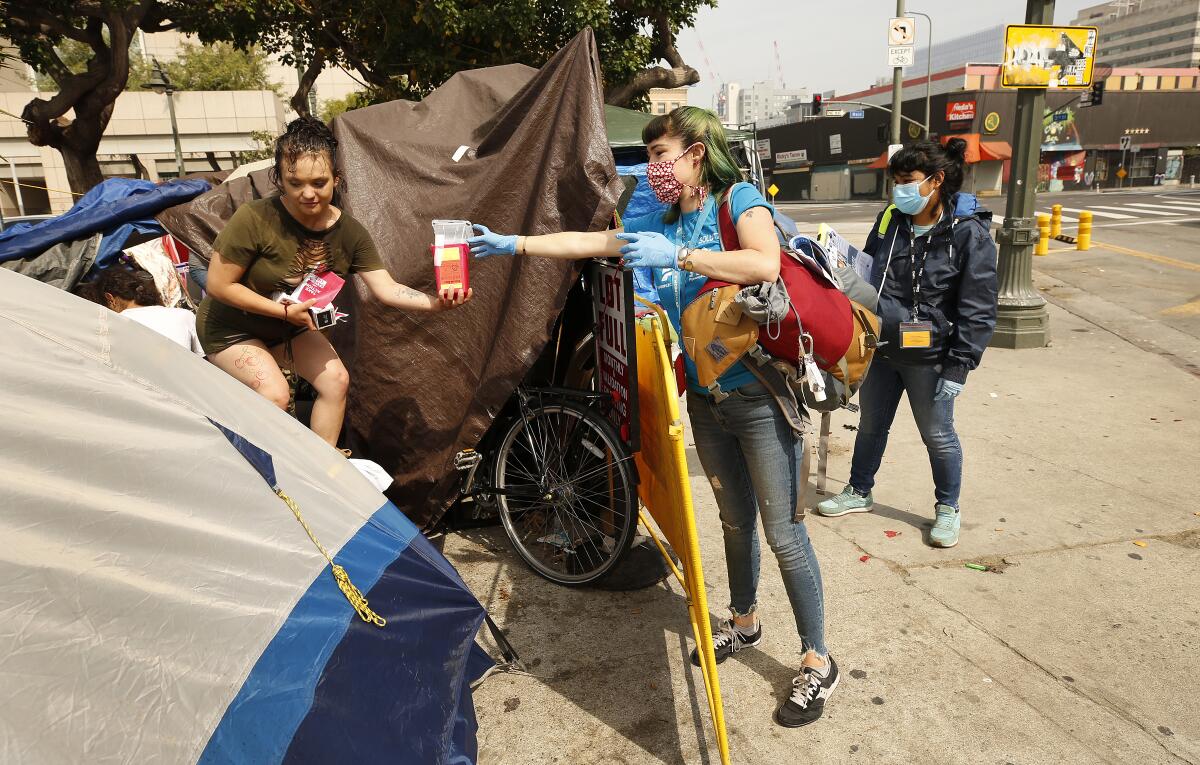
“Social distancing is what everyone does with homeless people,” said UCLA associate professor Randall Kuhn, co-author with Culhane of the early paper.
Testing of homeless people got off to a slow start, and an unknown number of homeless people might have died of stroke, cardiac arrest or other causes without their conditions being recognized as complications of COVID-19. Not all jurisdictions track deaths of homeless people, and homelessness is not always noted on death certificates.
“It’s hard to say that there have not been super-spreader events among people experiencing homelessness because we are far from having universal surveillance testing and most cases have been asymptomatic,” Bobby Watts, chief executive of the National Health Care for the Homeless Council in Nashville, said in an email.
Robert Kim-Farley, epidemiologist and infectious disease expert at the UCLA Fielding School of Public Health, said we won’t really know how homeless people in L.A. are faring until they undergo seroprevalence testing, which looks for antibodies left by past infections.
“The county is trying to do some additional targeting of subgroups, and it would make a lot of sense among homeless people, ” Kim-Farley said.
“I’m not so sure we can say there hasn’t been a huge hit,” Culhane said.
In the meantime, nearly every corner of the homeless delivery system has been modified to meet the COVID-19 challenge. Hundreds of wash stations have been placed near homeless encampments, pop-up testing went up on skid row and the Venice Boardwalk, and 26 city recreation centers were turned into temporary shelters, although most have since been closed — prematurely, critics said.
At the peak 26 parks and recreation centers in Los Angeles were being used as homeless shelters. Now there are seven.
Project Roomkey, the hotel program, fell short of its goal but placed more than 4,000 medically fragile homeless individuals in lodgings. The city suspended encampment sweeps, although some service providers are worried about a recent City Council vote to resume cleanups around bridge-housing shelters, which are intended to be transitions to permanent housing.
“Cleanings are good but disrupting people’s lives is not a positive thing,” said Dr. Coley King, director of homeless services at the Venice Family Clinic.
“The Centers for Disease Control guidance has not changed on how to handle encampment cleanups: by not disrupting the people,” Marston said. “We’re hoping to find some middle ground, maintaining the cleanliness everybody wants to see but so we’re not putting people at further risk unnecessarily.”
Outreach workers handed out masks, food and water, while screening homeless people for virus symptoms and educating them about social distancing and other precautions.
“Quite a few teams are out there every day advocating for people to see if they need water, food and to do wellness checks so any symptoms are quickly evaluated … and to see if they need to go to the emergency room or be referred to isolation or quarantine,“ said Dr. Silvia Prieto, a county Department of Public Health official.
At the Salvation Army’s shelter in Bell, one of the largest in the nation, the population was more than halved, from 480 in March to 220. Two-person sleeping cubicles were reduced to one and residents sit two to a table in the cafeteria, separated by blue plexiglass.
“When it first started, people used to line up with masks hanging half off their face. Now they are very diligent about masks and social distancing,” said Bell Shelter Director Steve Lytle. “It is certainly a more muted environment.” He added that the shelter put on a Juneteenth celebration, a pride event and an In-N-Out burger truck day to lift spirits.
“It can be a little bit overwhelming after a while; you can’t be yourself at times,” said Bell Shelter resident Mahuro Cortez, 49. “But it feels so good to have a place to be.”
On skid row, homeless people are taking their health into their own hands. Stephanie Arnold Williams cranked out masks from her sewing station in a big white tent at 5th and San Pedro streets, and the Los Angeles Community Action Network ginned up sidewalk wash stations from barrels.
At a recent Sunday Strong event at Community Action Network’s headquarters at 6th Street and Gladys Avenue , scores of people ran their hands under a wash station, grabbed masks and danced, pranced and vogued up a socially distanced line for sack meals with a side of hand sanitizer. The food was provided by grass-roots groups Miss Rodgers’ Neighborhood, Polo’s Pantry and Eayikes.
“Just because they’re homeless doesn’t mean people are not concerned about their health,” General Dogon, an organizer with the network, said over the ear-splitting sounds of Marvin Gaye and Watts 103rd Street Rhythm Band.
“We can’t let our guard down. These are very vulnerable people,” Kim-Farley said.
More to Read
Sign up for Essential California
The most important California stories and recommendations in your inbox every morning.
You may occasionally receive promotional content from the Los Angeles Times.
